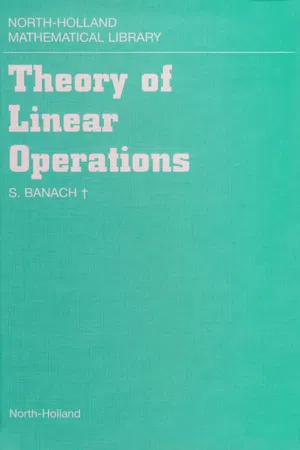
- 248 pages
- English
- ePUB (mobile friendly)
- Available on iOS & Android
Theory of Linear Operations
About This Book
This classic work by the late Stefan Banach has been translated into English so as to reach a yet wider audience. It contains the basics of the algebra of operators, concentrating on the study of linear operators, which corresponds to that of the linear forms a 1 x 1 + a 2 x 2 +... + a n x n of algebra.The book gathers results concerning linear operators defined in general spaces of a certain kind, principally in Banach spaces, examples of which are: the space of continuous functions, that of the p th -power-summable functions, Hilbert space, etc. The general theorems are interpreted in various mathematical areas, such as group theory, differential equations, integral equations, equations with infinitely many unknowns, functions of a real variable, summation methods and orthogonal series.A new fifty-page section (``Some Aspects of the Present Theory of Banach Spaces'') complements this important monograph.
Frequently asked questions
Information
Groups
§1. Definition of G-spaces





§2. Properties of sub-groups

Theorem 1.
Table of contents
- Cover image
- Title page
- Table of Contents
- North-Holland Mathematical Library
- Copyright page
- Preface
- Introduction
- Chapter I: Groups
- Chapter II: General vector spaces
- Chapter III: F-spaces
- Chapter IV: Normed spaces
- Chapter V: Banach spaces
- Chapter VI: Compact operators
- Chapter VII: Biorthogonal sequences
- Chapter VIII: Linear functionals
- Chapter IX: Weakly convergent sequences
- Chapter X: Linear functional equations
- Chapter XI: Isometry, equivalence, isomorphism
- Chapter XII: Linear dimension
- Weak convergence in Banach spaces
- Remarks
- Index
- Some aspects of the present theory of Banach spaces
- Bibliography